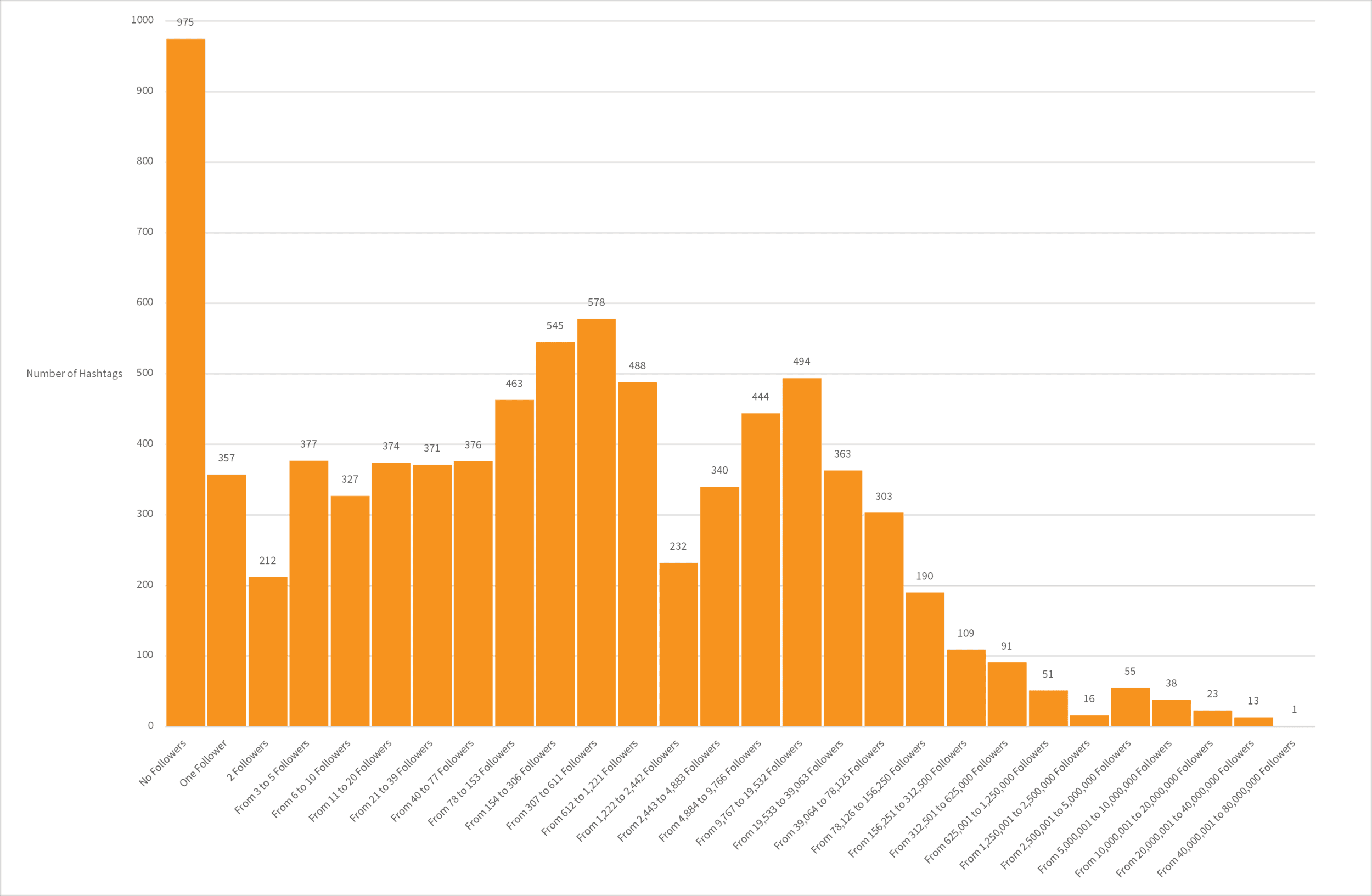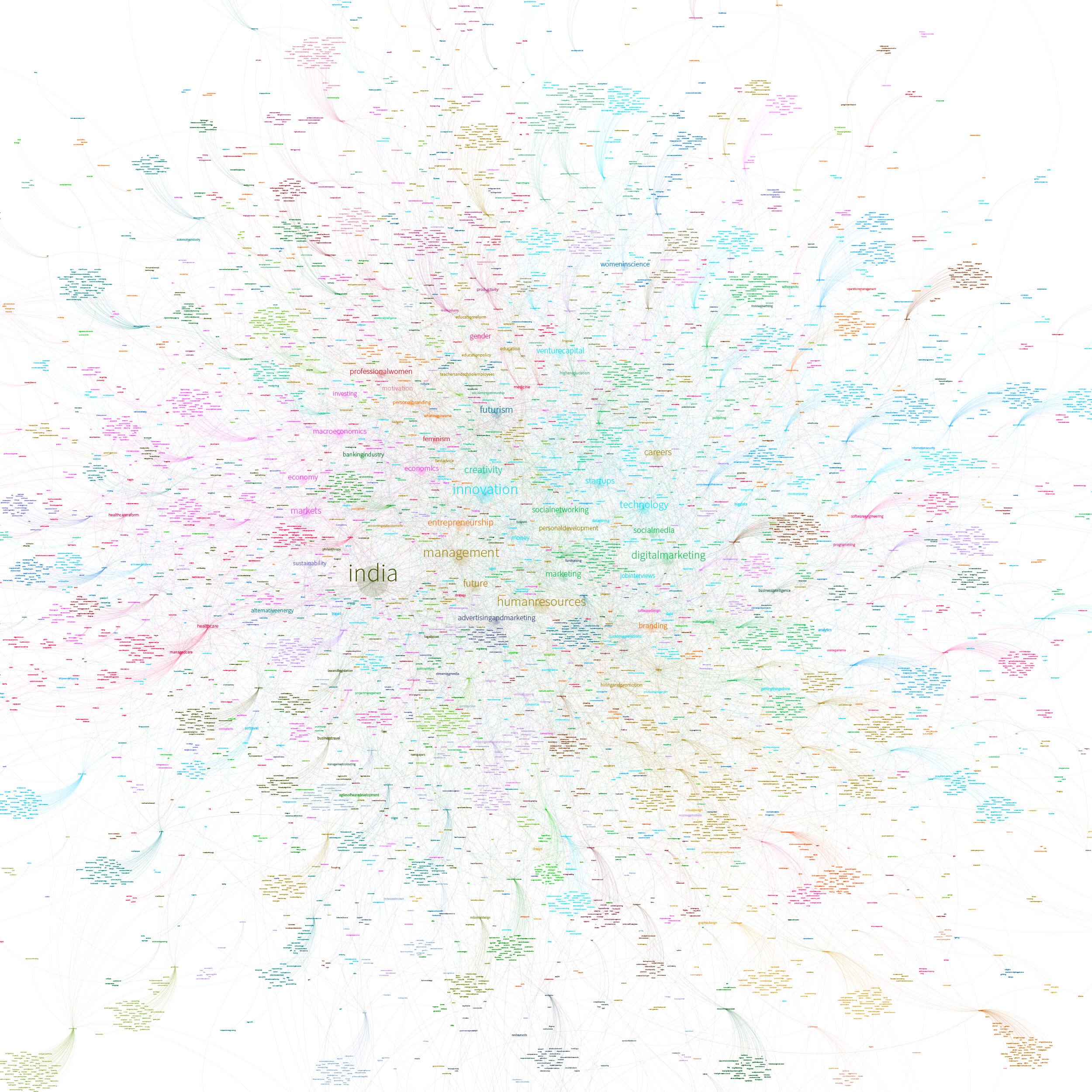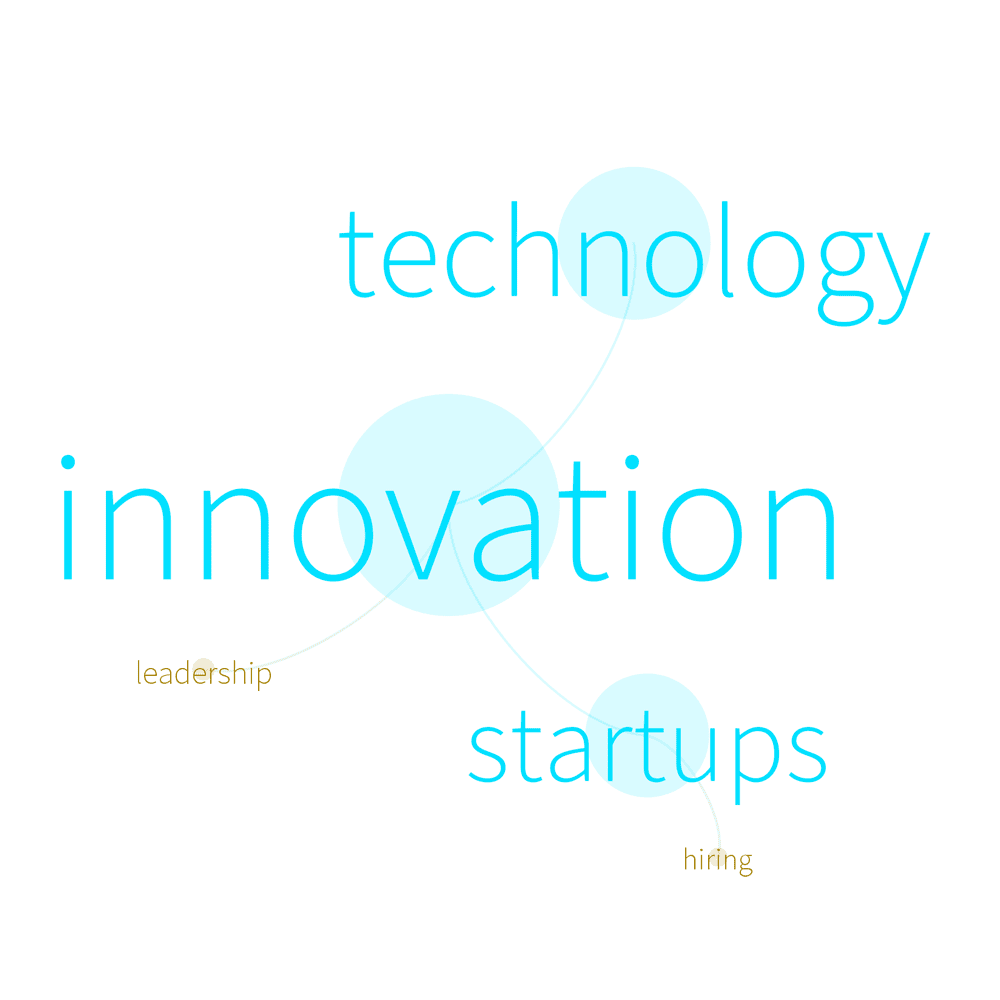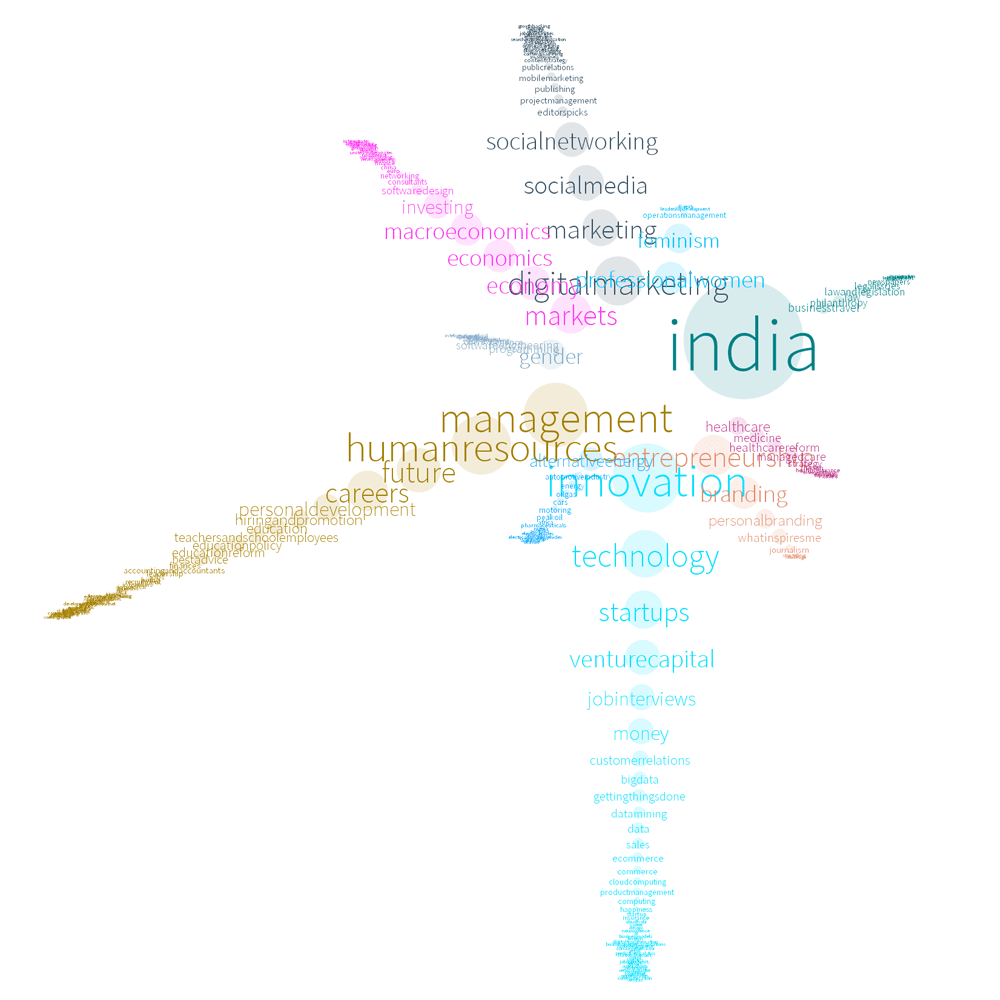LinkedIn Hashtags: The Last Word
Introduction
This article will give you some helpful advice on how to make the most of LinkedIn hashtags for B2B Marketing. You’ll be able to boost the organic reach of content you post on your own LinkedIn account and on your LinkedIn company page.
It also includes some of our findings from having researched the follower numbers and relationships between 8,500 individual LinkedIn Hashtags. This in-depth analysis creates opportunities to use LinkedIn hashtags strategically as part of your content planning as well as content promotion.
Read on to find out all you need to know about how LinkedIn hashtags work, what the top hashtags are on LinkedIn, where and how you can use Hashtags, ways to use hashtags to maximise your organic reach and engagement on LinkedIn, how you can use hashtags to refine or expand your audience, and even how you can use hashtag analysis to shape your content strategy and not just as window dressing on your LinkedIn posts.
LinkedIn is the world’s biggest business-oriented social network. Making the most of the features that LinkedIn has to offer is essential to B2B marketers and anyone looking to learn more about business, enhance their career or grow their company by finding new recruits and customers.
Sign up for our newsletter
Get the latest news and ideas from 1827 Marketing sent directly to your in-box.
You will receive an email from us every couple of months, and you can opt out at any time.
Just like Twitter, Facebook and Instagram, LinkedIn allows you to add hashtags to posts. And, just like on those other platforms, if you see a hashtag on a LinkedIn post, clicking it will take you to a page with posts that have the same hashtag.
LinkedIn, like Instagram and Facebook, allows you follow hashtags that you’re interested in. Twitter doesn’t really have this option. If you’re fascinated as by #digitalmarketing and #marketingautomation as we are, there are hashtags on LinkedIn that you can follow to find posts and articles that are relevant to your interest.

Why Use LinkedIn Hashtags
There are two principle reasons to use hashtags on LinkedIn: reach and relevance. Mastering LinkedIn hashtags is essential if you want to get people to see your post on LinkedIn or increase views on your LinkedIn published content. Maximising the effectiveness of organic content using LinkedIn hashtags is a cost-effective alternative – and often a complement – to paid advertising strategies on LinkedIn .
Hashtags help increase your reach and allow you to share content with impact because of how the LinkedIn algorithm works .When you add a post to LinkedIn, the algorithm shows it to people who it thinks will want to engage with it. Your followers, especially if they’re people who have engaged with your previous content, will see your latest post appear on their timelines.
Your post will be shown to people who are following the hashtags that you include. It won’t be shown to everyone who is following a particular hashtag. Just adding #management won’t guarantee your post will reach over 36 million hashtag followers, but it will be shown to a selection of people who follow that hashtag that the algorithm thinks will like your content. If that goes well, and #management followers like, share and comment on your post, it will be shown to more followers of that hashtag as well as to people who follow the people that engaged with what you posted.
Adding a hashtag to a post also means that your post will appear on that hashtag’s page. This is another way for your content to reach the right audience even if they aren’t part of your LinkedIn network or haven’t been selected to have the post shown to them in their own feed. Anyone researching a topic by using LinkedIn hashtags may see your post on the hashtag page, giving them a fresh opportunity to discover more about you and your business.
Hashtags are searchable, so if someone searches on LinkedIn for one of the hashtags that your posts use, there’s a chance they will find it in the search results, creating yet another opportunity for you to expand your audience.
Hashtags aren’t just a signal to the algorithm. Perhaps more importantly, they’re a signal to your audience about what’s most important in your content by highlighting the most relevant topic. This is why it’s not always wise to go solely for the hashtags that have the most followers. If you can find a niche hashtag that has fewer followers but that is more precisely matched to your topic or brand, you’ll get a higher level of engagement because of the high degree of relevance. Using the most relevant hashtag, even if it only has a few thousand followers, can get you more reach than always going for the ones with millions of followers.
There’s a further reason to go for the most relevant hashtag rather than the biggest. The really big ones have a lot of content streaming through them at an extremely high rate. Highly relevant niche hashtags that have fewer followers usually have less frequent posts. That means that content the you post to a niche hashtag has more chance of being at the top of the page for that hashtag for longer, extending the overall exposure of your post over time.
The Benefits of Following LinkedIn Hashtags
Using LinkedIn hashtags isn’t just about putting them in your own content. It’s also wise to choose some to follow for yourself.
The most obvious reason for this is that it will help you to keep abreast of the latest news and trends in the business topics that interest you. It will help you to be better at your current job, and it might even help you to find your next one.
Following hashtags and paying attention to the content in your timeline that results can be helpful in building your personal and company brand. People appreciate good curators of content as well as good original sources of content. If you are actively liking, commenting on, and sharing the best content that you think would be of interest to your network, you will gradually raise your profile on LinkedIn without having always to originate your own content.
This can work for you personally or for your company. Conversations that arise on LinkedIn when someone comments on a great campaign, an innovative use of design, an issue to do with equal opportunities in the workplace, a major product launch or a feat of engineering are some of the most memorable and useful aspects of the LinkedIn community.

Using Hashtags on LinkedIn Company Pages
Hashtags on Company Posts
If you have a LinkedIn company page you can use hashtags in company page posts as well as in posts on your personal LinkedIn Profile.
Company pages often don’t have as many followers as individual members have in their own personal LinkedIn networks, so using LinkedIn hashtags wisely in company page posts can be even more important in getting better organic reach on LinkedIn.
Since hashtags stand out on posts a bit more than all the other words, it’s important to choose LinkedIn hashtags for posts on company pages that match your brand’s tone of voice and values. In this context, the hashtags are saying something extra about what your company thinks is important, and so they have to align with your brand.
People often wonder if you can add hashtags to LinkedIn articles as well as to posts. This isn’t really possible, but LinkedIn’s advice, which we agree with, is to make good use of hashtags when you share an article you have written in the LinkedIn post you compose to announce and promote it. As soon as you publish an article you’re encouraged to tell people about it. This is your opportunity to add LinkedIn hashtags.
Hashtags on company Pages
LinkedIn encourages you to add up to three hashtags to your company page. LinkedIn gives instructions for how to do this here .
One reason for adding hashtags to your company page is that your company will be able to share, like and comment on posts from other people and organisations who are using that hashtag. If you are a page administrator or content administrator for the page, you will see your three hashtags listed on the admin view of your company page. Clicking on one of the hashtags will take to your that hashtag’s feed, but you’ll be viewing it as your company profile, not as your personal profile. Any actions you take here will be made on behalf of your organisation rather than you yourself. In this way, you can get your company or brand to take part in the conversations on the network.
For example, if your organisation has a strong commitment to the environment and you follow the relevant hashtags on your company page, you will have a chance to comment on issues and share relevant content ‘officially’ as your company – raising people’s awareness of your brand positioning on these issues. Hashtags are often used on social media platforms as part of campaigns for ethics, equality and social justice, and this feature gives your brand a further opportunity to have a role in these if you wish.
The Community Hashtag section of a LinkedIn Company Page shows the trending posts from your organisation for the hashtags you choose as company hashtags when you create your company page. This image is from 1827 Marketing’s own company page and it draws attention to two of our recent posts about #digitalmarketing and #marketingautomation.
A further reason to add hashtags to company pages is that they then appear as ‘Community Hashtags’ in your company page for regular (non-admin) viewers. If you have posted content using those hashtags, they will appear as ‘trending content’ on your page for those hashtags, providing another opportunity for people to discover posts from your company that have high relevance for them and for your brand.
When we wrote this article, our own ‘Community Hashtag’s section at the bottom of our LinkedIn company page had automatically featured a couple of posts from us about #digitalmarketing and #marketingautomation.

How to Choose Hashtags
Finding LinkedIn hashtags
The simplest way to find the right hashtags on LinkedIn is to search for them. Using the search bar at the top of the LinkedIn web page or mobile app, you can type the topic (i.e. ‘marketing strategy’) or your best guess at the hashtag (i.e. #MarketingStrategy) and the search results will include matching hashtags.
If you prefer, you can even look for a hashtag directly by editing the URL in your browser. LinkedIn hashtag URLs begin with ‘https://www.linkedin.com/feed/hashtag/?keywords=’ and end with the hashtag. So the URL for #MarketingStrategy is:
https://www.linkedin.com/feed/hashtag/?keywords=marketingstrategy
You’ll notice that you’re told the number of followers, which for this hashtag is almost 80,000, and you’re given the opportunity to follow the hashtag yourself.
The Hashtag page also gives you a few more clues for the best way to use LinkedIn hashtags for marketing. You’ll also see a list of posts that have already used that hashtag, which you can sort by ‘Top’ (i.e. most engagement) or ‘Recent’. Reading a few of these posts will help you to decide if this hashtag really is relevant for the content that you have in mind. Words like ‘hosting’ and ‘networking’ could refer to human interactions or computing. It’s a good idea to see how a potentially ambiguous hashtag is being used in the wild.
Thinking about the number of posts and their recency will also give you some idea about how much content is typically posted to this hashtag. If that means your own post is going to go whizzing by in an instant, you might think about adding less popular or slower moving hashtag.
LinkedIn hashtags are case-insensitive, but when you use them it’s best practice to capitalise the words within them – like #MarketingStrategy. It helps all readers to understand what you mean, and it particularly helps people who use assistive technologies because many of these tools understand capitalisation within hashtags.
How Many LinkedIn Hashtags to Use
It’s generally accepted that three hashtags is the optimum number of hashtags to use. If you decide to add a fourth that will be OK. More than 5 begins to look spammy and desperate, and in doing so undermines the credibility of the content that you have to offer. Having said that, we often sneak ‘#B2B’ in on our content as the fourth one because it’s super-relevant to our audience and it’s short so we like to think it doesn’t look like we’re stuffing our content with hashtag spam.
For your three hashtags, we recommend choosing a couple that have a large number of followers, and one that may only have followers in the thousands but which are highly relevant for your content and its target audience. Getting a balance of breadth and niche will maximise your reach to the right people.
You might find your post trending on LinkedIn if you have a post that’s popular for a hashtag, and that’s easier to achieve on mid-scale ones rather than once that have tens of millions of followers.
Creating New Hashtags on LinkedIn
It’s very easy to invent your own hashtag if you wish. Simply putting a ‘#’ followed by any letters and numbers will create that hashtag for you on LinkedIn. It will immediately get its own hashtag page.
Think carefully before you decide to do this. In our analysis of 8,500 LinkedIn hashtags, we found 1,350 that only had one or two followers. Perhaps slightly depressingly, this includes plausible-sounding hashtags like #PersonalPride which had no followers at all at the time of writing (it may go up by the time you read this).
Creating new hashtags is a tricky issue. Every hashtag, including #management, #innovation, #gender and #ai started with no followers. If you really believe you have come up with something that can get a substantial following or if you are launching a campaign with sufficient investment to get people to follow it, go ahead and make it. But unlike Twitter, widespread use of a hashtag isn’t all that helpful unless it also gains a reasonable number of followers. On LinkedIn hashtag follower count is more important than hashtag trending.
If you’re a small company thinking of creating a hashtag for your brand name, think again. The best way to build a following around your company is to use LinkedIn’s @companyname feature which will take people to your company page.
There’s nothing sadder than a young and optimistic-sounding startup that has made a hashtag with only one or two followers. To give some perspective #apple has fewer than 25,000 followers and #microsoft has only around 250,000. Inventing new hashtags is rarely a path to fame and fortune, and is more often a path to disappointment. No marketing manager wants a meeting with their boss only to be told that there are hashtag typos on LinkedIn that have more followers than their campaign hashtag.
However, if you do create your own hashtag, you should at least follow it. That simple act will place you above the nearly 1,000 hashtags that we found where even that hadn’t happened.
Having said that, hashtags are also a cultural phenomenon and it’s OK to have some fun with them. They are a heightened form of language. You can use them self-consciously and ironically and people will understand and enjoy the joke. If your own personality or brand tone of voice fits, it might be entertaining to go ahead with a hashtag like #LivingLaVidaLoca .Although this one has only one follower at time of writing, and a total of six posts – including one that features a donkey.
Trending hashtags on LinkedIn
If you’re used to Twitter and Instagram, you might be surprised that finding trending hashtags on LinkedIn, or even trying to get a hashtag to trend, is almost irrelevant on LinkedIn.
LinkedIn doesn’t really have a ‘trending hashtags’ feature. Instead, LinkedIn shows people the most popular and engaging content for any given hashtag on each hashtag page, and features a curated set (by LinkedIn’s editorial team) of the most relevant and interesting articles on the LinkedIn home page. Your own feed will show you the top posts that are most relevant to you. This selection will be influenced by which hashtags you follow, but it doesn’t draw attention to trending hashtags as such.
LinkedIn’s emphasis is on engaging with people and content. Rightly, in our view, LinkedIn’s focus is on trending content rather than trending hashtags. LinkedIn seems to work on the assumption that people follow the topics they’re interested in, and this means that paying attention to follower counts for hashtags is more important than trying to discover which hashtags are trending.

The Most Popular LinkedIn Hashtags
As you would expect, our research into thousands of LinkedIn hashtags included working out which ones had the most followers. The table here lists the top 32 LinkedIn hashtags and the number of followers they had when we researched them.
You might wonder why we chose to list the top 32. It’s because these 32 hashtags combined have more followers than all of the other hashtags that we found put together. There is an enormously long tail of barely-followed hashtags, and a very high concentration of followers in a small number of hashtags at the top end of the scale.
Rank | Hashtag | Number of Followers |
|---|---|---|
1 | 67,641,554 | |
2 | 38,793,607 | |
3 | 36,011,638 | |
4 | 33,267,183 | |
5 | 27,386,165 | |
6 | 26,439,260 | |
7 | 25,215,033 | |
8 | 24,582,604 | |
9 | 23,502,972 | |
10 | 22,739,610 | |
11 | 22,526,424 | |
12 | 22,266,896 | |
13 | 21,245,873 | |
14 | 20,352,567 | |
15 | 19,709,775 | |
16 | 19,324,643 |
Rank | Hashtag | Number of Followers |
|---|---|---|
17 | 19,064,814 | |
18 | 19,013,874 | |
19 | 18,677,111 | |
20 | 18,061,063 | |
21 | 18,035,557 | |
22 | 17,938,741 | |
23 | 17,711,268 | |
24 | 17,205,067 | |
25 | 16,705,464 | |
26 | 16,613,752 | |
27 | 16,286,244 | |
28 | 15,780,551 | |
29 | 14,725,873 | |
30 | 14,414,942 | |
31 | 14,359,246 | |
32 | 14,163,638 |
Hashtag Popularity Varies Widely

This chart shows how many hashtags there are on LinkedIn with different ranges of followers. From 1827 Marketing’s analysis of 8,500 LinkedIn hashtags, 975 LinkedIn hashtags had no followers at all and 377 LinkedIn hashtags had between 3 and 5 followers. Note that on this chart, the number of followers doubles with each column. The column on the right is a range of 40,000,000 to 80,000,000 followers (only #India is in this category) whereas the column next to it is from 20,000,001 to 40,000,000 followers and columns in the middle are for hashtags with follower counts in the 10s of thousands rather than millions.
The number of followers for individual hashtags varies widely. In our analysis of 8,500 LinkedIn hashtags, we found nearly 1,000 that didn’t have any followers at all. This shows the importance of researching a hashtags before you use them.
A few hashtags with no followers are typos among hashtags with no or few followers, but a great number of them are vanity hashtags that are for small companies or for underpowered marketing campaigns. In fact some typos have many more followers. #Leadeship (which we think was supposed to be #Leadership ) has more than 100 followers.
This chart supports the points made above about (a) not making up new hashtags unless you’re really confident it will grow and be valuable to the LinkedIn community, and (b) remembering to follow your own hashtags if you do create one.
Please note the unusual scale on the column graph above. The column on the left is for hashtags with no followers, and the one on the right is for hashtags with up to 80 million followers. Each column’s number of followers is twice that of the one to its left.
You might prefer the following graph, which simply shows how many followers each of the 8,500 hashtags that we looked at has, from the fewest (zero) to the most (#India with over 67 million followers). In this image it’s really clear that there’s a high concentration of followers in a few big hitting hashtags.

LinkedIn Hashtag Relationships

A network analysis diagram of LinkedIn hashtags showing hashtags with many followers mostly in the centre, and clusters of hashtags that are often used together. Text and blob size indicates number of followers.
Besides researching the number of followers that different LinkedIn hashtags have, we looked at how the different hashtags relate to each other.
The above diagram is a map of the network of LinkedIn hashtags that we researched. Don’t worry if you can’t read every word – the overall shape and clustering is what matters. Lines connecting hashtags mean that those hashtags are being used together in LinkedIn posts. The colour coding shows how LinkedIn hashtags form into clusters of hashtags that are often associated with each other.
In the middle of the graph you can see LinkedIn hashtags that have more followers and that have more diverse connections to the clusters around the edges. The size of the circles and text give a small clue about the relatively number of followers these hashtags have.

The clusters of hashtags around the outside reinforce our advice about mixing large-scale hashtags with hashtags with smaller follower numbers when you post. Around the edges of the network diagram there are many hashtags that are essentially sub-hashtags of others. Their topics are typically more precise and narrow than the topic that they spring from. These are essentially niche hashtags – not terribly well connected to other topics – but potentially a more refined and focused approach to finding your audience.
If you were to go the LinkedIn Hashtag page of one the niche hashtags mentioned above, you would most likely see posts that were almost all about related topics. Niche hashtags are almost always in semantically-related company. That’s important when you think about the experience your reader will have of your LinkedIn post. If they find your post on a hashtag page, it will be in the context of semantically related posts. If they click on the hashtag in your post, they’ll find themselves looking at posts that address similar topics to yours. Those experiences can reinforce your brand positioning as an expert because you’ll be addressing a niche issue and you’ll be discovered in the context of related subject matter.
LinkedIn Hashtag Context and Connections
What about the opposite of niche? We analysed our network to find the major LinkedIn hashtags that were connected to the most diverse set of hashtag clusters.
These hashtags represent highly important topics that cut across different communities of interest. Planning and posting content around these large connecting LinkedIn hashtags would give you confidence that you are addressing the major issues among LinkedIn users. Developing content that provides an interesting point of view about a major topic in relation to a niche topic would be a good strategy to generate more reach for your posts if you wish to drive awareness and positioning.

The five major connecting hashtags will strike you as very familiar if you spend much time on LinkedIn
The sixth most connecting hashtag is #India .This makes sense since every possible business topic will be relevant to people using a hashtag for an entire country.
When you have insight into important niche hashtags and also the major connecting hashtags on LinkedIn, you can stop only thinking about hashtags as something that you add to content after it has been written. You can start to also think of LinkedIn hashtags as providing inspiration and guidance for the content that you write, planning content that is written with those hashtags in mind.
Let’s say you’re a specialist engineering company. One part of your strategy would be to find the right niche hashtags, but another part could be to prepare content that’s specifically about any hiring that your company is doing, whether your products are innovative or help others to innovate, how they interoperate with other technologies, what your company’s stance on leadership is, and how your business is relevant to startups (or maybe is a startup itself). Now you have five ideas for content – all connected to your core business and its customers – but also tied into the primary concerns of LinkedIn’s general membership.
One LinkedIn hashtag that we believe is very interesting from a content strategy and development perspective is #ProfessionalWomen .This hashtag has strong links to other diverse, interesting and influential hashtags. Making content that’s relevant to #ProfessionalWomen would put it in context with topics including leadership, motivation, venture capital, innovation, creativity and personal development – each of which have high follower counts and generally high engagement.

LinkedIn’s Major Hashtag Topic Clusters
LinkedIn hashtag major topic clusters that cover almost everyone on LinkedIn
The network analysis diagram that we’re sharing here shows lots of different small clusters of hashtags forming little ‘hashtag communities’. There are more than 100 different hashtag communities in it.
What may not be so obvious from the diagram is that there are around ten hashtag topic clusters that, together, have the vast majority of followers.
If you want to cover the waterfront and develop content across just ten topics that can reach pretty much everyone on LinkedIn in a structured manner, organised around topics that have become evident from people’s online behaviour, these ten LinkedIn megatopics deserve your attention. For example, this could be useful for a management consultancy that wants to talk about all the key topics and issues that face business in a way that reaches the widest possible audience, or a business school looking to reorganise and recategorize parts of its curriculum to match how people really organise topics.
The list of ten topic clusters provided here could work as content pillars or course categories so that your content strategy is aligned to the interests of your audience. Cross tabulate this with the five main topics of interest outlined above, and you will have developed a planning matrix with the potential to deliver over a year’s worth of relevant and high-engagement content.
In some instances, the combination of hashtags that form communities seems surprising or counter-intuitive at first. The clustering is calculated computationally, not manually. It does not take account of hashtag meanings – only that whether they often appear together or not. But what quickly becomes apparent is a very modern, very adaptable perspective on the world of business and commerce.
1. Personal and Professional Development
Around 176 Million Followers
Hashtags in this topic cluster include education, personal development, careers, hiring and promotion and management. Taken together, it suggests that might regard development as a continuum encompassing education, personal development and work with no real boundaries between them.
2. Business Model Innovation
Around 163 Million Followers
Hashtags in this topic cluster include innovation, technology, startups, bigdata and data mining. But also there is customer relations, venture capital and money. This suggests funding and customer experience is top-of-mind among entrepreneurs alongside innovation.
3. Digital Marketing
Around 110 Million Followers
Hashtags in this cluster include digital marketing, marketing, social media, publishing and content strategy. It’s also where ‘#projectmanagement’ ended up, which might say something about the complexity of today’s marketing campaigns.
4. Economics & Growth
Around 109 Million Followers
Hashtags in this cluster include markets, economy, macroeconomics, investing, networking, Euro and China. It’s clear the focus is on growth opportunities at the macroeconomic scale with a focus on growth and investment.
5. Law, Regulation & Society
Around 102 Million Followers
In this topic cluster, clearly legal-oriented hashtags such as law, legalissues, lawandlegislation and legaprofession sit alongside private equity and philanthropy. This leads us to believe that there is an opportunity to connect legal discussions directly to ethical and social issues. #India is in this community. These issues are relevant to ‘#India but there’s no reason to narrow this topic to one country. #India connects to nearly every topic on LinkedIn.
6. Branding and Advertising
Around 65 Million Followers
Focusing on entrepreneurship, branding, storytelling and #whatinspiresme as well as personalbranding and storytelling, this topic area is the upbeat, creative and strategic companion to the Digital Martketing topic cluster. It’s a chance to showcase and debate the best creative work.
7. Medicine & Healthcare
Around 43 Million Followers
This health and healthcare topic cluster includes a number of health and managed care-related hashtags, but it’s also home to #insurance and ‘#internetofthings, which suggests that digital transformation of healthcare is relevant here too.
8. Women & Leadership
Around 39 Million Followers
#ProfessionalWomen and #feminism sit alongside #LeadershipDevelopment, #diversity, #BoardsOfDirectors and #SocialImpact. Taken together, a picture emerges of a progressive and inclusive approach to business leadership and society.
9. Energy and Transport
Around 38 Million Followers
#AlternativeEnergy, #OilGas and #PeakOil coincide with #Motoring, #Cars, #Africa and #Nigeria to suggest that this is an industry undergoing rapid and disruptive transformation as we switch to more sustainable models.
10. Software Engineering
Around 38 Million Followers
This topic cluster is focused on programming, software engineering, user experience, industrial engineering and web development, and also has hashtags for specific development environments. #Gender also appears prominently in this topic. We’re not sure if this is a result of the positive efforts that have been made to encourage gender equality in software engineering teams, or if it’s a legacy of debates over gender discrimination, but it’s notable that #Gender is here.
After the Last Word: The Next Step
The humble hashtag can be a strategic content promotion and planning tool in the right hands. We hope that you found something of use in what turned out to be a really deep-dive into LinkedIn Hashtags.
If you’d like to discuss how 1827 Marketing can help with content marketing and marketing automation, we’re here for you. Feel free to book a demo using the button below.
Have a B2B marketing project in mind?
We might be just what you’re looking for






